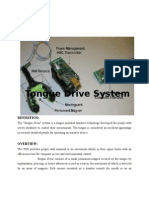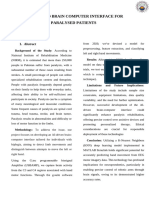Braingate Page 1 of 46
Braingate Page 1 of 46
Uploaded by
prosperity215Copyright:
Available Formats
Braingate Page 1 of 46
Braingate Page 1 of 46
Uploaded by
prosperity215Original Title
Copyright
Available Formats
Share this document
Did you find this document useful?
Is this content inappropriate?
Copyright:
Available Formats
Braingate Page 1 of 46
Braingate Page 1 of 46
Uploaded by
prosperity215Copyright:
Available Formats
BRAINGATE
Page 1 of 46
ABSTRACT
A range of applications and products with a combination of nanotechnology, biotechnology and information technology are under development to directly improve the lives of people with severe injuries or medical conditions. Solutions range from better implants and prosthetics to brain-machine interfaces and they already are in early stages of development and has working prototypes. Nanomedical and bionic products that could directly improve sensory, motoric and other functions cover all aspects of the human body. These visions go far beyond the current implant technologies under development. The best solution for elderly and disabled people is the use of Brain gate. The technology gives the disabled people the opportunity to lead a normal life inspite of not being able to use their body parts. Infact this technology is a boon for physically challenged and elderly people.
COLLEGE OF ENGINEERING, CHERTHALA
BRAINGATE
Page 2 of 46
NEED FOR BRAINGATE
Individuals with severe paralysis usually have intact brain function but are unable to move due to injury or disease affecting the spinal cord, nerves, or muscles. People who have such severe physical impairments have limited movement ability, and some are unable to use their arms, legs or hands. This is often referred to as quadriplegia. In all primates (including macaque monkeys and humans), the neurons in the motor cortex of the brain normally send their instructions (signals) out to the spinal cord, which in turn drives muscles. Consider the simple voluntary task of moving one finger. This act takes some intention and a simple plan that originates in the cerebral cortex. A few milliseconds before voluntary movement, neural signals, in the form of a stream of impulses, increase in the primary motor cortex. This increase in impulse rate of a large group of neurons carries the commands for movement. When the connection from the brain to the spinal cord has severed, as in severely paralyzed people, the central control for motor behavior in the brain remains healthy, but the command signals are ineffective because they are cut off from the muscles. Individuals who are unable to use their hands cannot write, type, use computers or operate basic controls and equipment such as light switches, remote control devices, and other appliances with their hands. There are currently available assistive devices that provide benefits to many of these individuals. These devices may be mobile (move with the individual) and/or utilized in their chronic care environment such as the home setting. Assistive devices have been developed that rely on some form of non-invasive switch that can be controlled by the individual. Strategies for switch driven assistive devices include the use of tongue or sip and puff switches, or the use of single switches connected to a digit or body part that can still be controlled by the individual. Other systems rely on the tracking of an individuals eye movement to create a computer input signal. They typically require the individual to use some other function, such as an eye blink, head movement, vocalization or pushing air (sip and puff) to create simple control responses.
Currently available assistive devices have other significant limitations for both the person in need and the caregiver. The location of these various types of switches must be adjusted frequently as the individual moves in relation to the device. Since many of these
COLLEGE OF ENGINEERING, CHERTHALA
BRAINGATE
Page 3 of 46
people have limited muscle control, adjustment can be a time consuming and constant process for the caregiver, significantly affecting the reliability and accuracy of these devices. In addition, these devices are obtrusive and may prevent the individual from being able to establish eye contact with caregivers. Devices that require the use of the mouth or of the eyes are sometimes considered disfiguring when placed on the individuals head. The level of control that can be achieved with the existing assistive devices is also problematic. The speed of communication for tasks such as typing or changing programs on a personal computer can be very limited. The rate of communication with assistive devices is so limited that they are frequently abandoned by those in need of caregivers. These devices, therefore, have limitations in functionality, ease of use and speed of use and so alternative approaches and devices are needed for many of these people. These types of assistive devices are not neural prosthetics in the sense that they do not directly utilize neural information or signals directly from within the brain. Over the last 30 years the National Institutes of Health (NIH) has actively funded numerous programs to develop neural prosthetics to assist these individuals in regaining their independence. The development of an implantable neural interface that could potentially provide a permanent, reliable and fast output signal to a personal computer would likely be a significant improvement in the quality of communication and computer control available to people with such disabilities. Further developments based on such a system could conceivably allow these people to control devices beyond personal computers such as environmental controls, medical devices designed to power their own limbs, and robotic equipment such as wheelchairs. The operational foundation of the BrainGate Neural Interface System is based on the finding that with intact brain function, neural signals are generated even though they are not sent to the arms, hands, and legs. These signals can be interpreted by a computer to provide an alternate neural pathway to the normal neural pathway that is now non-functional. The system operates by continuously detecting and digitizing the activity of neuron populations in the primary motor area of the cerebral cortex. External components process and decode these signals into a prediction of desired movement serves as a control signal that the individual can then use to indicate intentions by controlling (moving) a cursor on a computer screen. The goal of BrainGate Neural Interface System development program is to create a product that can potentially allow quadriplegic patients to recover a host of abilities that normally rely
COLLEGE OF ENGINEERING, CHERTHALA
BRAINGATE
Page 4 of 46
on the hands. The system could be used in the individuals home environment or even be mobile with the patient. Such a system could someday potentially restore the ability to interface with a computer and other devices at a level of speed, accuracy and precision that is comparable to the use of hands by a non-disabled person.
BRAINGATE
COLLEGE OF ENGINEERING, CHERTHALA
BRAINGATE
Page 5 of 46
Figure 1
BrainGate is made up of a sensor, which is implanted in the brain and attached to the neurons. The upper left image shows the device that attaches to the implant on the outside of the brain. The white box is about the size of a VHS tape and contains software that digitizes the signals coming from the neurons. The image labeled "cart" depicts the computer system that interprets the digital code.
INTRODUCTION
COLLEGE OF ENGINEERING, CHERTHALA
BRAINGATE
Page 6 of 46
BrainGate was developed by the bio-tech company Cyberkinetics in 2003 in conjunction with the Department of Neuroscience at Brown University. BrainGate is an investigational technology which is being developed to detect brain signals and to allow people with paralysis to use those signals to control assistive devices. The system is based on neuroscience, engineering and computer science research at Brown University. The device was designed to help those who have lost control of their limbs, or other bodily functions. The computer chip, which is implanted into the brain, monitors brain activity in the patient and converts the intention of the user into computer commands. BrainGate is based on technology to sense, transmit, analyze and apply the language of neurons. Currently the chip uses 100 hair-thin electrodes that 'hear' neurons firing in specific areas of the brain, for example, the area that controls arm movement. The activity is translated into electrically charged signals and is then sent and decoded using a program, thus moving the arm. BrainGate is a path to a better way of life for severely motor-impaired individuals. Through years of advanced research, BrainGate enables these people with the ability to communicate, interact and function through thought. BrainGate's mission is to further the advancement of this life-changing technology to promote wider adoption to help impaired individuals communicate and interact with society. For instance, the Cyberkenetics BrainGate Neural Interface is currently the subject of a pilot clinical trial being conducted under an Investigational Device Exemption (IDE) from the FDA (U.S. Food and Drug Administration). The system is designed to restore functionality for a limited, immobile group of severely motor-impaired individuals.
HISTORY
COLLEGE OF ENGINEERING, CHERTHALA
BRAINGATE
Page 7 of 46
Over the past few years, there has been substantial scientific and medical progress toward designing powerful restorative neural interfaces for people with paralysis or limb loss. Much of this progress has resulted from decades of fundamental research, funded almost entirely by federal sources, including the National Institutes of Health, the Department of Veterans Affairs, and the Department of Defense, with critical help from philanthropic foundations. In 2002, a Brown University startup medical device company, Cyberkinetics, Inc. (later, Cyberkinetics Neurotechnology Systems, Inc.) was formed to collect the regulatory permissions and financial resources required to launch pilot clinical trials of a first-generation neural interface system. The companys efforts and substantial initial capital investment led to the translation of the preclinical research at Brown University to an initial human device, the BrainGate Neural Interface System. The BrainGate system uses a brain-implantable sensor to detect neural signals that are then decoded to provide control signals for assistive technologies. In 2004, Cyberkinetics received from the U.S. Food and Drug Administration (FDA) the first of two Investigational Device Exemptions (IDEs) to perform this research. Hospitals in Rhode Island, Massachusetts, and Illinois were established as clinical sites for the pilot clinical trial run by Cyberkinetics. Four trial participants with tetraplegia (decreased ability to use the arms and legs) were enrolled in the study and further helped to develop the BrainGate device. While scientific progress towards the creation of this promising technology has been steady and encouraging, Cyberkinetics financial sponsorship of the BrainGate research without which the research could not have been started - began to wane. In 2007, in response to business pressures and changes in the capital markets, Cyberkinetics turned its focus to other medical devices. Although Cyberkinetics own funds became unavailable for BrainGate research, the research continued through grants and subcontracts from federal sources. By early 2008 it became clear that Cyberkinetics would eventually need to withdraw completely from directing the pilot clinical trials of the BrainGate device. Also in 2008, Cyberkinetics spun off its device manufacturing to new ownership, Blackrock Microsystems, Inc., which now produces and is further developing research products as well as clinically-validated (510(k)cleared) implantable neural recording devices. Beginning in mid 2008, with the agreement of Cyberkinetics, a new, fully
COLLEGE OF ENGINEERING, CHERTHALA
BRAINGATE
Page 8 of 46
academically-based IDE application (for the BrainGate2 Neural Interface System) was developed to continue this important research. In May 2009, the FDA provided a new IDE for the BrainGate2 pilot clinical trial. The BrainGate2 pilot clinical trial is directed by faculty in the Department of Neurology at Massachusetts General Hospital, a teaching affiliate of Harvard Medical School; the research is performed in close scientific collaboration with Brown Universitys Department of Neuroscience, Division of Engineering, and Brown Institute for Brain Sciences, and the Rehabilitation Research and Development Service of the U.S. Department of Veterans Affairs at the Providence VA Medical Center. This interdisciplinary research team includes scientific partners from the Functional Electrical Stimulation Center at Case Western Reserve University and the Cleveland VA Medical Center. As was true of the decades of fundamental, preclinical research that provided the basis for the recent clinical studies, funding for BrainGate research is now entirely from federal and philanthropic sources. The BrainGate Research Team at Brown University, Massachusetts General Hospital and Providence VA Medical Center comprises physicians, scientists, and engineers working together to advance understanding of human brain function and to develop neurotechnologies for people with neurological disease, injury, or limb loss. These technologies will become a powerful means to restore communication, mobility, and independence to people with paralysis. The teams investigator-initiated research is focused solely on advancing the science and medicine of restorative neural interfaces.
THE HUMAN BRAIN
The brain is the most complex organ found among the carbon-based life forms. So
COLLEGE OF ENGINEERING, CHERTHALA
BRAINGATE
Page 9 of 46
complex it is that we have only vague information about how it works. The average human brain weights around 1400 grams. The most relevant part of brain concerning BMIs is the cerebral cortex. The cerebral cortex can be divided into two hemispheres. The hemispheres are connected with each other via corpus callosum. Each hemisphere can be divided into four lobes. They are called frontal, parietal, occipital and temporal lobes. Cerebral cortex is responsible for many higher order functions like problem solving, language comprehension and processing of complex visual information. The cerebral cortex can be divided into several areas, which are responsible of different functions. This kind of knowledge has been used when with BCIs based on the pattern recognition approach. The mental tasks are chosen in such a way that they activate different parts of the cerebral cortex. Cortical Area Auditory Association Area Auditory Cortex Speech Center (Brocas area) Prefrontal Cortex Motor Association Cortex Primary Motor Cortex Primary Somatosensory Cortex Sensory Association Area Visual Association Area Wernickes Area Function Processing of auditory information Detection of sound quality (loudness, tone) Speech production and articulation Problem solving, emotion, complex thought Coordination of complex movement Initiation of voluntary movement Receives tactile information from the body Processing of multi sensory information Complex processing of visual information Language comprehension
BASIC PRINCIPLE
Main principle behind this interface is the bioelectrical activity of nerves and muscles. It is now well established that the human body, which is composed of living tissues, can be considered as a power station generating multiple electrical signals with two internal sources,
COLLEGE OF ENGINEERING, CHERTHALA
BRAINGATE
Page 10 of 46
namely muscles and nerves. We know that brain is the most important part of human body. It controls all the emotions and functions of the human body. The brain is composed of millions of neurons. These neurons work together in complex logic and produce thought and signals that control our bodies. When the neuron fires, or activates, there is a voltage change across the cell, (~100mv) which can be read through a variety of devices. When we want to make a voluntary action, the command generates from the frontal lobe. Signals are generated on the surface of the brain. These electric signals are different in magnitude and frequency. By monitoring and analyzing these signals we can understand the working of brain. When we imagine ourselves doing something, small signals generate from different areas of the brain. These signals are not large enough to travel down the spine and cause actual movement. These small signals are, however, measurable. A neuron depolarizes to generate an impulse; this action causes small changes in the electric field around the neuron. These changes are measured as 0 (no impulse) or 1 (impulse generated) by the electrodes. We can control the brain functions by artificially producing these signals and sending them to respective parts. This is through stimulation of that part of the brain, which is responsible for a particular function using implanted electrodes. The principle of operation behind the BrainGate System is that with intact brain function, brain signals are generated even though they are not sent to the arms, hands and legs. The signals are interpreted and translated into cursor movements, offering the user an alternate "BrainGate pathway" to control a computer with thought, just as individuals who have the ability to move their hands use a mouse. BrainGate consists of a sensor that is implanted on the motor cortex of the brain and a device that analyzes brain signals. BrainGate collects and analyzes the brainwaves of individuals with pronounced physical disabilities, turning thoughts into actions. The patient directs his thoughts to move the cursor on his computer screen. The sensor in his brain picks up those hard-to-detect electrical signals and sends them through three computers that process them into signals just like those from a computer mouse. These processors, which currently sit on a cart and are not mobile, will eventually become wireless and small enough to fit inside the body.
COLLEGE OF ENGINEERING, CHERTHALA
BRAINGATE
Page 11 of 46
The surgeon makes a craniotomy that is the diameter of a 50-cent piece. The sensor, which is the size of a baby aspirin with 100 tiny hair-like appendages, is implanted in the region that issues commands to the arms. The software tells the surgeon exactly where to go and the whole surgical procedure takes about two and a half hours. Afterward only a pennysized connector to the computer can be seen from the outside.
Figure 2
BASIC COMPONENTS
1. THE CHIP
COLLEGE OF ENGINEERING, CHERTHALA
BRAINGATE
Page 12 of 46
The Chip is equipped with 96 recording electrodes spaced 0.4mm apart. It receives data at the rate of 10,000 signals per second per electrode. The end size of the chip is 4mm x 4mm x 1.5mm. The current array, now being implanted in patients in clinical trials, consists of 100 platinum-tipped silicon electrodes, insulated with Parylene-C. Individual electrodes, 96 of which are available for recording neuronal activity, are 1 mm long and spaced just 400 m apart.
2. THE AMPLIFIER
The amplifier amplifies the neural signal sensed by the chip. It amplify multiple channels of simultaneously recorded neural activity at a very high spatial and temporal resolution
3. THE CONNECTOR
The pedestal, which contains amplifier and signal-conditioning hardware, connects to a cable that carries the amplified neural signals to computers resting on a cart near the patient.
4. THE CONVERTER
The signal travels to a shoebox-sized amplifier where it is converted to optical data and bounced by fiber-optic cable to a computer.
5. THE COMPUTER
Brain Gate learns to associate patterns of brain activity with particular imagined movements - up, down, left, and right - and to connect those movements to a cursor.
6. THE ACTUATORS
Proposed actuators include a cursor on a computer screen (to operate the computer and its
COLLEGE OF ENGINEERING, CHERTHALA
BRAINGATE
Page 13 of 46
software), a motorized wheelchair, a semiautonomous robot, a prosthetic limb, or a functional electrical stimulation (FES) device that could reanimate a paralyzed limb.
7. THE DECODER
Between the sensor and actuator lies the decoder, which receives neural data recorded by the sensor, discerns the users intention, and converts that intention into a command signal for the actuator. Cyberkinetics Neurotechnology Systems, Inc. (Foxborough, MA), has improved the quality of human cursor control by decoding cursor velocity from motor cortical activity using a Kalman filter
8. THE MOTOR CORTEX SIMULATOR
As the technology evolved, the engineering team developed a PC-based system, called the motor cortex simulator, featuring 100 channels of firing neurons and a touch screen that let researchers alter the modulation of the neurons. One PC was used as a function generator, simulating the firing of the neurons, and two others served as signal processors. This tool allowed us to validate all parts of the system, both hardware and software. It evaluated both the throughput speed and the accuracy of capturing the analog waveforms and processing them into a digital pulse.
THE CHIP
Brain chips often fail because of pinholes in their insulation coat. These pinholes allow
COLLEGE OF ENGINEERING, CHERTHALA
BRAINGATE
Page 14 of 46
chemicals and fluid to come in direct contact with the sensitive circuitry of the chip, which results in immediate failure of the chip. Thus the coating material of brain chip was of utmost importance. Because of the size constraint, encapsulating the chip in a thick layer of insulation was not a viable option. Instead, the chip implanted was coated in monolithic silicone. Its electrodes were coated with Paralyne-C, topped with platinum tips and insulated with thin glass. The combination of these materials allowed the chip to be small, durable, and efficient. The chip recorded brain signals using integrated CMOS circuitry, which is an array of recording electrodes. Just like repeating an experiment ensures statistically significant results, using multiple electrodes improved the reliability of the recorded data.
Figure 3 In 1998 the first BCI was implanted into a human brain. However, this primitive design had limited functionality. It read neural signals, but produced an impractical output; the person with this chip could type only three characters per minute on a virtual keyboard. Three years later, John Donoghue and a group of researchers established Cyberkinetics: Neurotechnology Systems, a public company to commercially develop BCIs. The brain chip was designed to provide a balance between safety, durability, and functionality. The chip had to be small enough to not hinder normal brain function and nondestructive to neural communication to avoid brain damage. At the same time, the chip had to be resistant to corrosion caused by brain chemicals. While fulfilling these safeties requirements, the primary function of the chip was to record and transmit the delicate signals of the brain.
COLLEGE OF ENGINEERING, CHERTHALA
BRAINGATE
Page 15 of 46
The chip was equipped with 96 recording electrodes spaced 0.4mm apart. It received data at the rate of 10,000 signals per second per electrode. The end size of the chip was 4mm x 4mm x 1.5mm and was implanted a little over 1mm into Nagles brain. In developing the BCI, researchers implanted a brain chip in subjects with full neural and motor capacity. The subjects performed elementary actions, such as raising an arm, and the neuron activity was recorded using the chip. These experiments allowed for the simultaneous recording of both hand motion and neural activity. The BrainGate Neural Interface created a direct link between Nagles brain and a computer in the following way: when he thought move cursor down, his cortical neurons fired in a distinctive pattern. The brain chip sensed these electrical signals The entire array is carved from a block of boron-doped silicon, with each electrode isolated by a glass layer. The electrodes have a single recording site at their tip. The arrays have been evaluated with different forms of connectors and surgical methods in a longitudinal series of preclinical studies leading up to the pilot human trial.
THE AMPLIFIER
The signals travel to a titanium connector attached to the skull and then via fiber-optic cabling to amplifiers that augment the signals and route them to a computer, which processes them and turns them into the desired output.
COLLEGE OF ENGINEERING, CHERTHALA
BRAINGATE
Page 16 of 46
Broadband Light Amplifier on a Chip
Figure 4
Cornell scientists have created a broadband light amplifier on a silicon chip, a major breakthrough in the quest to create photonic microchips. In such microchips, beams of light traveling through microscopic waveguides will replace electric currents traveling through microscopic wires. The amplifier uses a phenomenon known as four-wave mixing, in which a signal to be amplified is "pumped" by another light source inside a very narrow waveguide. The waveguide is a channel only 300 x 550 nanometers (nm = a billionth of a meter, about the length of three atoms in a row) wide, smaller than the wavelength of the infrared light traveling through it. The photons of light in the pump and signal beams are tightly confined, allowing for transfer of energy between the two beams. The advantage this scheme offers over prior methods of light amplification is that it works over a fairly broad range of wavelengths. Photonic circuits are expected to find their first applications as repeaters and routers for fiber-optic communications, where several different wavelengths are sent over a single fiber at the same time. The new broadband device makes it possible to amplify the multiplexed traffic all at once. The process also creates a duplicate signal at a different wavelength, so the devices could be used to convert a signal from one
COLLEGE OF ENGINEERING, CHERTHALA
BRAINGATE
Page 17 of 46
wavelength to another. Even though four-wave mixing amplifiers have been made with optical fibers, such devices are tens of meters long. Scientists are working to create photonic circuits on silicon because silicon devices can be manufactured cheaply, and photonics on silicon can easily be combined with electronics on the same chip. Many groups are trying to develop optical amplifiers that are silicon compatible. The waveguides are silicon channels surrounded by silicon dioxide. Computer simulations by the Cornell team predicted that a waveguide with a cross section of 300 x 600 nm would support four-wave mixing, while neither a slightly smaller one -- 200 x 400 nm -- nor a larger one -- 1,000 x 1,500 nm -- would. When Lipson's Cornell Nanophotonics Group built the devices, those numbers checked out, with best results obtained with a channel measuring 300 x 550 nm.
The devices were tested with infrared light at wavelengths near 1,555 nm, the light used in most fiber-optic communications. Amplification took place over a range of wavelengths 28 nm wide, from 1,512 to 1,535 nm. Longer waveguides gave greater amplification in a range from 1,525 to 1,540 nm. The scientists predict that even better performance can be obtained by refining the process. They also predict that other applications of four-wave mixing already demonstrated in optical fibers will now be possible in silicon, including all-optical switching, optical signal regeneration and optical sources for quantum computing.
THE CONNECTOR
The pedestal, which contains amplifier and signal-conditioning hardware, connects to a cable that carries the amplified neural signals to computers resting on a cart near the patient. A bundle of gold wires as thick as a coaxial cable runs from a connector in patients scalp to a refrigerator-sized cart of electronic gear. Through this gold wires are threaded from the array to an external pedestal connector attached to patient's skull. The sensor is connected by wires to a small pedestal on the scalp. This pedestal allows
COLLEGE OF ENGINEERING, CHERTHALA
BRAINGATE
Page 18 of 46
the BrainGate computer to be connected to the brain. The chip was then implanted at and transmitted them to a pedestal plug that was directly attached to his skull by a fiber optic cable. A small wire connects the sensor to a pedestal that is placed on the skull, extending through the scalp. An external cable connects the pedestal to a cart containing computers, signal processors and monitors that enable the study operators to determine how well study participants can control devices driven by their neural output that is, by thought alone.
Figure 5
THE DECODER
. The decoder illustrated here takes motor cortex neuronal activity (firing rate) and converts it, through a mathematical filter, to intended hand motion. The computers translate hard-to detect brain signals to create the communication output using custom decoding software. The electrodes sense the electro-magnetic signature of neurons firing in specific areas of the brain (the area that controls arm movement). This activity is translated into electrically charged signals and sent to the computer. The computer decodes the signals from the neuron using a program, which can move either a robotic arm or a computer cursor.
COLLEGE OF ENGINEERING, CHERTHALA
BRAINGATE
Page 19 of 46
WORKING
COLLEGE OF ENGINEERING, CHERTHALA
BRAINGATE
Page 20 of 46
Figure 6 Neurons are cells that use a language of electrical impulses to communicate messages from the brain to the rest of the body. Several developments are being made to restore function, as well as to monitor, detect, and respond to a variety of neurological diseases and disorders. BrainGate offers a systems approach which applies the language of neurons in both short and long-term settings. The BrainGate system is a neuromotor prosthetic device consisting of an array of one hundred silicon microelectrodes, each of which is 1mm long and thinner than a human hair. The electrodes are arranged less than half a millimeter apart on the array, which is attached to a 13cm-long cable ribbon cable connecting it to a computer. BrainGate can sense, transmit, analyze and apply the language of neurons. Brain impulses detected by the BrainGate array are sent up via a set of fine wires that pierce the skull and scalp. These are attached by cable to a computerized system that can amplify these neurological impulses or "spikes" and translate them, in real time, into the
COLLEGE OF ENGINEERING, CHERTHALA
BRAINGATE
Page 21 of 46
desired actions.
Sense
BrainGate's unique technology is able to simultaneously sense the electrical activity of many individual neurons. The sensor consists of a silicon array about the size of a baby aspirin that contains one hundred electrodes, each thinner than a human hair. The array is implanted on the surface of the brain. In the BrainGate Neural Interface System, the array is implanted in the area of the brain responsible for limb movement. In other applications the array may be implanted in areas of the brain responsible for other body processes.
Transmit and Analyze
The human brain is a super computer with the ability to instantaneously process vast amounts of information. BrainGate's technology allows for an extensive amount of electrical activity data to be transmitted from neurons in the brain to computers for analysis. In the current BrainGate System, a bundle consisting of one hundred gold wires connects the array to a pedestal which extends through the scalp. The pedestal is connected by an external cable to a set of computers in which the data can be stored for off-line analysis or analyzed in real-time. Signal processing software algorithms analyze the electrical activity of neurons and translate it into control signals for use in various computer-based applications.
Apply
By using the BrainGate Neural Interface System, a person may be able to use his thoughts to control cursor motion and/or replicate keystrokes on a computer screen. In another example, a doctor may study patterns of brain electrical activity in patients with epilepsy before, during and after seizures.
WORKING PROCESS
COLLEGE OF ENGINEERING, CHERTHALA
BRAINGATE
Page 22 of 46
Figure 7 The BrainGate technology platform was designed to take advantage of the fact that many patients with motor Impairment have an intact brain that can produce movement commands. This may allow the BrainGate system to create an output signal directly from the brain, bypassing the route through the nerves to the muscles that cannot be used in paralyzed people.
Figure 8 After the operation the mental activity can be tracked on two large monitors, one of which displayed a graph of red and green spiking lines. Each spike represented the firing of clusters of neurons. As the patient performed specific actions in his mind's eye - move arm left,
COLLEGE OF ENGINEERING, CHERTHALA
BRAINGATE
Page 23 of 46
move arm up - the electrodes picked up the patterns of nearby neuron groups. Then the BrainGate amplifies and records the corresponding electrical activity. Over dozens of trials the computer built a filter that associated specific neural patterns with certain movements. Later, when the patient again mentally pictured the motions, the computer translated the signals to guide a cursor.
Figure 9
The reason a BCI works at all is because of the way our brains function. Our brains are filled with neurons, individual nerve cells connected to one another by dendrites and axons. Every time we think, move, feel or remember something, our neurons are at work. That work is carried out by small electric signals that zip from neuron to neuron as fast as 250 mph. The
COLLEGE OF ENGINEERING, CHERTHALA
BRAINGATE
Page 24 of 46
signals are generated by differences in electric potential carried by ions on the membrane of each neuron. Although the paths the signals take are insulated by something called myelin, some of the electric signal escapes. Scientists can detect those signals, interpret what they mean and use them to direct a device of some kind. It can also work the other way around. For example, researchers could figure out what signals are sent to the brain by the optic nerve when someone sees the color red. They could rig a camera that would send those exact signals into someone's brain whenever the camera saw red, allowing a blind person to "see" without eyes.
BCI Input and Output
One of the biggest challenges facing brain-computer interface researchers today is the basic mechanics of the interface itself. The easiest and least invasive method is a set of electrodes -- a device known as an electroencephalograph (EEG) -- attached to the scalp. The electrodes can read brain signals. However, the skull blocks a lot of the electrical signal, and it distorts what does get through. To get a higher-resolution signal, scientists can implant electrodes directly into the gray matter of the brain itself, or on the surface of the brain, beneath the skull. This allows for much more direct reception of electric signals and allows electrode placement in the specific area of the brain where the appropriate signals are generated. This approach has many problems, however. It requires invasive surgery to implant the electrodes, and devices left in the brain long-term tend to cause the formation of scar tissue in the gray matter. This scar tissue ultimately blocks signals. Regardless of the location of the electrodes, the basic mechanism is the same: The electrodes measure minute differences in the voltage between neurons. The signal is then amplified and filtered. In current BCI systems, it is then interpreted by a computer program. In the case of a sensory input BCI, the function happens in reverse. A computer converts a signal, such as one from a video camera, into the voltages necessary to trigger neurons. The signals are sent to an implant in the proper area of the brain, and if everything
COLLEGE OF ENGINEERING, CHERTHALA
BRAINGATE
Page 25 of 46
works correctly, the neurons fire and the subject receives a visual image corresponding to what the camera sees. Another way to measure brain activity is with a Magnetic Resonance Image (MRI). An MRI machine is a massive, complicated device. It produces very high-resolution images of brain activity, but it can't be used as part of a permanent or semi permanent BCI. Researchers use it to get benchmarks for certain brain functions or to map where in the brain electrodes should be placed to measure a specific function. For example, if researchers are attempting to implant electrodes that will allow someone to control a robotic arm with their thoughts, they might first put the subject into an MRI and ask him or her to think about moving their actual arm. The MRI will show which area of the brain is active during arm movement, giving them a clearer target for electrode placement. A more difficult task is interpreting the brain signals for movement in someone who can't physically move their own arm. With a task like that, the subject must "train" to use the device. With an EEG or implant in place, the subject would visualize closing his or her right hand. After many trials, the software can learn the signals associated with the thought of handclosing. Software connected to a robotic hand is programmed to receive the "close hand" signal and interpret it to mean that the robotic hand should close. At that point, when the subject thinks about closing the hand, the signals are sent and the robotic hand closes. A similar method is used to manipulate a computer cursor, with the subject thinking about forward, left, right and back movements of the cursor. With enough practice, users can gain enough control over a cursor to draw a circle, access computer programs and control a TV . It could theoretically be expanded to allow users to "type" with their thoughts. Once the basic mechanism of converting thoughts to computerized or robotic action is perfected, the potential uses for the technology are almost limitless. Instead of a robotic hand, disabled users could have robotic braces attached to their own limbs, allowing them to move and directly interact with the environment. This could even be accomplished without the "robotic" part of the device. Signals could be sent to the appropriate motor control nerves in the hands, bypassing a damaged section of the spinal cord and allowing actual movement of the subject's own hands.
COLLEGE OF ENGINEERING, CHERTHALA
BRAINGATE
Page 26 of 46
BrainGate is based on research conducted by Brown University professor John Donoghue, who is Cyberkinetics' founder and chief scientific officer. His research focuses on deciphering the way the brain turns thought into the signals that cause actions such as arm movement. For example, he explained, when a person wants to move an arm, millions of neurons emit pulses in a complex pattern that the spinal cord reads and translates into a signal that controls the muscles. Using multielectrode recording arrays and functional magnetic resonance imaging (fMRI) techniques, Donoghue's research team has captured subjects' brain signals and then used digital signal processors (DSPs) and algorithms to translate them into a format that a computer can understand and process. The subject must first enter an MRI scanner. The scanner creates a magnetic field and uses radio signals to capture the brain's hemodynamic responses to the person's thoughts about moving, for example, a cursor or prosthesis. The hemodynamic responses include increased blood flow and hemoglobin supply to the neurons that are actively working.
CORTICAL PLASTICITY
COLLEGE OF ENGINEERING, CHERTHALA
BRAINGATE
Page 27 of 46
For years, the brain of an adult human was viewed as a static organ. When you are a growing, learning child, your brain shapes itself and adapts to new experiences, but eventually it settles into an unchanging state -- or so went the prevailing theory. Beginning in the 1990s, research showed that the brain actually remains flexible even into old age. This concept, known as cortical plasticity, means that the brain is able to adapt in amazing ways to new circumstances. Learning something new or partaking in novel activities forms new connections between neurons and reduces the onset of age-related neurological problems. If an adult suffers a brain injury, other parts of the brain are able to take over the functions of the damaged portion.
Why is this important for BCIs?
It means that an adult can learn to operate with a BCI, their brain forming new connections and adapting to this new use of neurons. In situations where implants are used, it means that the brain can accommodate this seemingly foreign intrusion and develop new connections that will treat the implant as a part of the natural brain.
SORTING THE DATA
COLLEGE OF ENGINEERING, CHERTHALA
BRAINGATE
Page 28 of 46
On the software side, Cyberkinetics has relied heavily on tools such as The MathWorks Mat lab to address many technical issues, and the team created diagnostic software that detects crosstalk between electrode channels. Even more significant, the engineers used software to devise a time-saving measurement tool for sorting the vast amount of neural data pouring into the system from the 96 channels. Before Almut Branner and her colleagues developed an automatic spike sorter, it could take up to an hour for engineers to classify the neural "spikes" or action potential waveforms from brain activity picked up by the BrainGate electrode array. Manual methods for detecting and classifying these neural spikes or action-potential waveforms had become too time consuming. Using software analysis of waveform shape and amplitude, researchers have to set up different classification rules for each of five waveforms coming from each channel. Classifying these waveforms is an essential preliminary step for devising the software-based rules that enable patients to perform control functions during their sessions with researchers and technicians. Yet this spike sorting was taking an hour or more in setup time. The new system, devised with the help of Mat lab and its signal-processing toolbox, now takes the continuous signal that comes in from the patient and makes decisions about whether the signal is noise or one of the action-potential waveforms. The process now takes just a few minutes. The automated spike sorter is also an essential step toward the goal of a future BrainGate system that could be operated by patients without the assistance of technicians. Eventually, the algorithm could perhaps be implemented on a DSP chip that is implanted in the body. This would greatly reduce the bandwidth of the signal that we now send out of the body. 30,000 data points per second are collected on every channel, and right now it is almost impossible to do this wirelessly.
CLOSE LOOK
COLLEGE OF ENGINEERING, CHERTHALA
BRAINGATE
Page 29 of 46
Figure 10
a, The BrainGate sensor (arrowhead), resting on a US penny, connected by a 13-cm ribbon cable to the Ti pedestal (arrow), which is secured to the skull. Neural signals are recorded while the pedestal is connected to the remainder of the BrainGate system (seen in d). b, Scanning electron micrograph of the 100-electrode sensor, 96 of which are available for neural recording. Individual electrodes are 1-mm long and spaced 400 m apart, in a 10 10 grid. c, Pre-operative axial T1-weighted MRI of the brain of participant 1. The arm/hand 'knob' of the right red arrow corresponds to the approximate location of the sensor implant site. A scaled projection of the 4 4-mm array onto the precentral knob is outlined in red.
COLLEGE OF ENGINEERING, CHERTHALA
BRAINGATE
Page 30 of 46
d, The first participant in the BrainGate trial (MN). He is sitting in a wheelchair, mechanically ventilated through a tracheotomy. The grey box (arrow) connected to the pedestal contains amplifier and signal conditioning hardware; cabling brings the amplified neural signals to computers sitting beside the participant. He is looking at the monitor, directing the neural cursor towards the orange square in this 16-target 'grid' task. A technician appears behind the participant.
SURGERY
In June 2004, after obtaining informed consent, a surgical procedure consisting of an
COLLEGE OF ENGINEERING, CHERTHALA
BRAINGATE
Page 31 of 46
incision and 3 cm diameter craniotomy located above the right primary motor cortex was conducted under general anesthesia. A 4x4 mm, 100 channel sensor was implanted on the surface of the cortex, in the precentral gyrus immediately posterior to the superior frontal sulcus, as identified on presurgical MRI. The surgery lasted approximately 3 hours and was uneventful. The patient was discharged to his primary residence 3 days post-surgery where he recovered for 3 days post-surgery where he recovered for three weeks prior to initiation of device testing.
How does the surgery work?
There will be two surgeries, one to implant the BrainGate and one to remove it. Before surgery, there will be several precautionary measures in order to prevent infection; patients will have daily baths with antimicrobial soap and take antibiotics. In addition, MRI scans will be done to find the best place on the brain for the sensor. Under sterile conditions and general anesthesia, a small hole will be drill into the skull and implant the sensor. Patients will receive post-surgical care including a CT scan, some blood tests, and wound care in the hospital for 1 to 5 days after surgery. The skin around the pedestal will need to be carefully monitored during the study. Detailed instructions will be provided so that the patients daily care provider can help with skin care. After the skin has healed, testing will begin.
Figure 11
Preliminary Observations of Device Safety
There were no post-surgical complications, which is supported by the continued ability to record neural activity. No adverse events or other study-related complications have been reported. Safety assessments include daily checks of connector, weekly nurse visits, and monthly
COLLEGE OF ENGINEERING, CHERTHALA
BRAINGATE
Page 32 of 46
physician exams including neurological and mental status exams.
Study Design
Key Study Eligibility Criteria Age 18 to 60 years Able to speak understandably Quadriplegia due to spinal cord injury, muscular dystrophy or stroke where quadriplegia is: Complete quadriplegia (bilateral C2-C4) Incomplete quadriplegia with muscle grade at specific cord levels as follows
3/5 at C5
2/5 at C6 < 2/5 at C7-T1 + lower extremities
12 months post-injury
SUMMARY OF INITIAL OBSERVATIONS
COLLEGE OF ENGINEERING, CHERTHALA
BRAINGATE
Page 33 of 46
Motor cortex neurons of humans remain active years after spinal cord injury. Modulation of neural activity is possible in MI in the absence of limb movement. Using the BrainGate system, the initial participant has immediately gained control of a computer interface, with no special training, and can operate the cursor while performing other voluntary motor tasks.
The control signal provided has the potential for 3 dimensions of control from the signals obtained in MI and this signal has been used to control a range of potentially useful devices including computers, robots, and prosthetic limbs.
These observations suggest that the system should be useful in any disabled patient with an intact motor cortex. This initial case report suggests that the BrainGate system, which uses a tested, validated sensor implant which is removable and replaceable, may offer patients with severe disability a universal operating system with which they can control devices in the environment around them.
PRELIMINARY DEVICE EFFICACY
COLLEGE OF ENGINEERING, CHERTHALA
BRAINGATE
Page 34 of 46
Device testing began on July 12, 2004 and continues at present, with more than 20 sessions being completed. Single-unit neuron recordings from motor cortex have been made over multiple sessions. The BrainGate System has been able to measure and record spike activity with a signal to noise >2. The patient is able to modulate or control neuronal activity. On multiple occasions, neuronal activity was increased when the patient was instructed to imagine moving his left hand and/or arm.
Neural Cursor Control Performance Over 4 Weeks
In 7 of 8 sessions conducted over 4 weeks, the patient reached 80 targets on the screen per session, significantly better than a control simulation. Instant control of the cursor was achieved without reported difficulty or significant level of concentration. The cursor was used in predefined tasks while the patient was speaking.
THE IMPEDANCE TESTER
In order to analyse how each electrodes function, manufacturing in Salt Lake City
COLLEGE OF ENGINEERING, CHERTHALA
BRAINGATE
Page 35 of 46
designed the automatic impedance tester. This automatic impedance tester can measure current in the range of 10 pA and voltages as low as 5 mV. Moreover, results of this impedance test of all 96 channels are graphically displayed on a monitor in just 10 s. Hardware consists of a 1x1 in circuit board embedded in the cable that connects to the pedestal mounted on the patients skull. To take a measurement, a technician simply flips a switch on the cable, sending a 1-kHz signal at 5 m V. In contrast to using a passive impedance tester, operators do not need to disconnect the patient from the BrainGate to do the test. During the test, the graphic display shows a map of the array system, with each channel appearing as a block with impedance values. We can set up desired parameters, i.e. the electrodes which are in the range of impedance of our desired choice. The channels in that particular range will show as black, those above the range in red and those below the range in yellow.
Figure 12 This colour code will make the process easier when we look into all 96 channels at the same time. For human clinical use, the acceptable operating range of impedance is between 100 and 800 K. The impedance tester can quickly identify problems such as leaks, shorts or poor connection in the array.
AREAS OF APPLICATION
COLLEGE OF ENGINEERING, CHERTHALA
BRAINGATE
Page 36 of 46
Communication
For people with locked-in syndrome - the inability to move and to speak despite being fully awake and alert (for example, due to brainstem injury or ALS) - restoration of easy communication is a priority. The BrainGate team is developing technologies that would reenable the ability to control a cursor on a computer screen or to type on a virtual keyboard, simply by thinking about the movement of one's own hand (for example, as if controlling a computer mouse). Initial progress toward this can be seen at:
Neuronal ensemble control of prosthetic devices by a human with tetraplegia Multi-state decoding of point-and-click control signals from motor cortical activity in a human with tetraplegia.
Prosthetics
One of the goals of implanted neural interfaces is to provide natural, real-time control of devices that would be helpful to people with paralysis or limb loss. The past few years have seen the development of markedly advanced prosthetics for people who have had one or both arms amputated due to trauma or vascular disease. These prosthetic limbs, however, require better controllers (than, for example, a series of switches placed under the foot). By using the brain signals directly related to intend movement of the hand will enable easier and more complex control over these superb prosthetic limbs. Similarly, for people with cervical spinal cord injury or brainstem stroke, the signals from the motor cortex have been disconnected from the limb. One approach to improve environmental control would be to provide safe and useful robotic limbs, which could be attached to a wheelchair and used much in the same way the arm and hand was used prior to injury to the nervous system. The real dream for the technology is to reconnect brain-to-limb. The Functional
COLLEGE OF ENGINEERING, CHERTHALA
BRAINGATE
Page 37 of 46
Electrical Stimulation Center at Case Western Reserve University and the Cleveland VA Medical Center, are working to develop systems that will allow people with paralysis to reanimate their own limbs, simply by thinking about the movement of that limb.
Sensors
Multiple neuroengineering challenges exist today in creating practical, chronic, multichannel neural recording systems for research and for human clinical neural interface application. Specifically:
persistent wired connections between user and recording system limit the mobility of both the transfer of high bandwidth signals to external (even distant) electronics normally requires premature data reduction (i.e., data loss, making potentially helpful signals unavailable for subsequent analysis or use)
risk of infection due to a percutaneous connector component
The BrainGate group is developing an approach to overcome these limitations via an entirely implantable, wirelessly powered and communicating, integrated neural recording micro system.
Neuroscience
Scientists have studied the activity of single neurons, mostly in animals, for more than half a century. New technologies provide the ability to record dozens or 100 or more neurons simultaneously. Beyond contributing to the development of technologies for the restoration of movement and communication in persons with paralysis or limb loss, pilot clinical trials of the BrainGate2 system also provide an extraordinary and rare opportunity to further our understanding of how the human brain works. For example: Currently studies are made on how ensembles of single neurons represent and process
COLLEGE OF ENGINEERING, CHERTHALA
BRAINGATE
Page 38 of 46
information in the human motor cortex. Investigations are made on how neuronal activities are modulated with general neural states (e.g. attention, sleep, etc.). These studies pose exciting theoretical and statistical challenges. To meet these challenges, our research also focuses on the development of new neurostatistical methodologies and algorithms that aim at uncovering meaningful spatiotemporal patterns of neural activity, especially their relationship to intended action, behavioral and cognitive states, and disease conditions.
Neurology
The ability to restore function after paralysis is only one potential benefit of harnessing the power of intracortical signals. BrainGate research team is also exploring the use of these information-rich neural signals to better understand and treat other neurological disorders and diseases. For example: 50 million people worldwide suffer from epilepsy. Approximately 30% of epilepsy patients continue to have seizures despite maximal medical management. The unprecedented level of detail enabled by recording ensembles of single neurons (10s-100s of neurons) not only will allow us to study how seizures start, but will also lead to the generation of warning signals and the creation of next-generation devices that can reduce or stop seizures. This hypothesis is tested with the help of patients with seizures who are already scheduled for pre-surgical recordings for epilepsy management, and this work may lead to a sea change in the way we treat and understand epilepsy.
COLLEGE OF ENGINEERING, CHERTHALA
BRAINGATE
Page 39 of 46
Figure 13
COLLEGE OF ENGINEERING, CHERTHALA
BRAINGATE
Page 40 of 46
FUTURE SCOPE
There is development underway on BrainGate to potentially provide limb movement to people with severe motor disabilities. The goal of this development program would be to allow these individuals to one day use their own arms and hands again. Limb movement developments are currently at the research stage and are not available for use with the existing BrainGate System. In addition, products are in development to allow for robotic control, such as a thought-controlled wheelchair. In the future, the BrainGate System could be used by those individuals whose injuries are less severe. Next generation products may be able to provide an individual with the ability to control devices that allow breathing, bladder and bowel movements. Cyberkinetics has a vision, but it is not promising miracle cures, or that quadriplegic people will be able to walk again yet. Their primary goal is to help restore many activities of daily living that are impossible for paralysed people and to provide a platform for the development of a wide range of other assistive devices. Today quadriplegic people are satisfied if they get a rudimentary connection to the outside world. This is a connection that is as good and fast as using their hands. It teach them to think about moving the cursor using the part of the brain that usually controls the arms to push keys and create, if you will, a mental device that can input information into a computer. That is the first application, a kind of prosthetic, if you will. Then it is possible to use the computer to control a robot arm or their own arm. Existing technology stimulates muscle groups that can make an arm move. The problem Surgenor and his team faced were in creating an input or control signal. With the right control signal they found they could stimulate the right muscle groups to make arm movement. Cyberkinetics hopes to refine the BrainGate in the next two years to develop a wireless device that is completely implantable and doesnt have a plug, making it safer and less visible. And once the basics of brain mapping are worked out there is potential for a wide variety of further applications. Surgenor also sees a time not too far off where normal humans are interfacing with
COLLEGE OF ENGINEERING, CHERTHALA
BRAINGATE
Page 41 of 46
BrainGate technology to enhance their relationship with the digital world if theyre willing to be implanted. If we can figure out how to make this device cheaper, there might be applications for people to control machines, write software or perform intensive actions. But thats a good distance away. Right now the only way to get that level of detail from these signals is to actually have surgery to place this on the surface of the brain. Its not possible to do this with a non-invasive approach. For example, you can have an EEG and if you concentrate really hard you can think about and move a cursor on a screen, but if someone makes a loud noise or you get interrupted, you lose that ability. What were trying to make here is a direct connection. The [BrainGate] is going to be right there and you wont have to think about it.
COLLEGE OF ENGINEERING, CHERTHALA
BRAINGATE
Page 42 of 46
FUTURE GOALS
Enable individuals with paralysis to use e-mail and telephones to communicate. Provide access to environmental controls, such as bed positioning, television, lights, and thermostats through a desktop application.
Improve mobility by interfacing with powered wheelchairs. Provide patients with the ability to adjust their body position to avoid pressure sores. Facilitate control over all of these actions and a range of other software and external device applications through a single, universal integrated interface.
COLLEGE OF ENGINEERING, CHERTHALA
BRAINGATE
Page 43 of 46
ADVANTAGES
The BrainGate system is based on cyber kinetics platform technology to sense, transmit analyze and apply the language of neurons. The Brain Gate Neural Interface System is being designed to one day allow the interface with a computer and / or even faster than, what is possible with the hands of a person. The Brain Gate System may offer substantial improvement over existing technologies . Currently available assistive device has significant limitations for both the peers and caregiver. For example, even simple switches must be adjusted frequent that can be time consuming. In addition, these devices are often obtrusive and user from being able to simultaneously use the device and at the same time contact or carry on conversations with others. Potential advantages of the Brain Gate System over other muscle driven or brain computer interface approaches include : its potential to interface with a compute weeks or months of training; its potential to be used in an interactive environment users ability to operate the device is not affected by their speech, eye movement noise; and the ability to provide significantly more usefulness and utility than other approaches by connecting directly to the part of the brain that controls hand gestures.
COLLEGE OF ENGINEERING, CHERTHALA
BRAINGATE
Page 44 of 46
DISADVANTAGES
The U.S. Food and Drug Administration (FDA) have not approved the Brain Gate Non Interface System for general use.
The Brain Gate System is an investigational device in the United States, and is status (Investigational Device Exemption). In the United States, this investigate can only be used in pre-marketing clinical trials approved by the FDA.
COLLEGE OF ENGINEERING, CHERTHALA
BRAINGATE
Page 45 of 46
CONCLUSION
BrainGate provides an opportunity for the physically challenged people to lead a normal life. It will overcome all present obstacles and will be soon be a boon for such people.
COLLEGE OF ENGINEERING, CHERTHALA
BRAINGATE
Page 46 of 46
REFERENCES
Multi-state decoding of point-and-click control signals from motor cortical activity in a human with tetraplegia Sung-Phil Kim; Simeral, J.D.; Hochberg, L.R.; Donoghue, J.P.; Friehs, G.M.; Black, M.J.; Neural Engineering, 2007. CNE '07. 3rd International IEEE/EMBS Conference on 2007 Page(s):486 - 489 Digital Object Identifier 10.1109/CNE.2007.369715 Case study: reliability of multi-electrode array in the knob area of human motor cortex intended for a neuromotor prosthesis application Saleh, M.; Caplan, A.H.; Serruya, M.; Donoghue, J.P.; Rehabilitation Robotics, 2005. ICORR 2005. 9th International Conference on 28 June-1 July 2005 Page(s):205 Digital Object Identifier 10.1109/ICORR.2005.1501085
2-5 May
32 IEEE engineering in medicine and biology magazine September/October 2006
Sensors for Brain-Computer Interfaces Options for Turning Thought into Action By Leigh R. Hochberg and John P. Donoghue
Mind control issue 13.03, March 2005 By Richard Martin http://www.wired.com/wired/archive/13.03/brain.html?pg=4 http://dsonline.computer.org/portal/cms_docs_computer/computer/homepage/Jan07/CO M_017-021.pdf.
COLLEGE OF ENGINEERING, CHERTHALA
You might also like
- Gazzaniga and Mangun 2014. The Cognitive NeurosciencesDocument1,187 pagesGazzaniga and Mangun 2014. The Cognitive NeurosciencesFelipe Quezada94% (31)
- Etienne Burdet, David W. Franklin, Theodore E. Milner - Human Robotics - Neuromechanics and Motor Control-The MIT Press (2013)Document290 pagesEtienne Burdet, David W. Franklin, Theodore E. Milner - Human Robotics - Neuromechanics and Motor Control-The MIT Press (2013)SIMET100% (1)
- How Literature Plays With The Brain: The Neuroscience of Reading and ArtDocument240 pagesHow Literature Plays With The Brain: The Neuroscience of Reading and ArtDPainter100% (2)
- 7 Triggers To YesDocument16 pages7 Triggers To YesSaket Sharma100% (1)
- Outsmart Yourself Brain-Based Strategies To A Better YouDocument210 pagesOutsmart Yourself Brain-Based Strategies To A Better YouRodrigo Castro100% (10)
- Categorically Unequal - Chapter 1Document27 pagesCategorically Unequal - Chapter 1Russell Sage Foundation100% (1)
- AbstractDocument9 pagesAbstractNazmeen BanuNo ratings yet
- Brain GateDocument9 pagesBrain GateTagore NavabothuNo ratings yet
- Brain Gate ReportDocument31 pagesBrain Gate ReportRahul Bansal50% (4)
- Seminar ReportDocument17 pagesSeminar Reportsudhir_raja_1No ratings yet
- Brain Gate LibreDocument3 pagesBrain Gate Libreanks1605No ratings yet
- Braingate Seminar Report 2008Document22 pagesBraingate Seminar Report 2008Sonali Sharma50% (2)
- Brain Computer InterfaceDocument6 pagesBrain Computer InterfaceVanga PrathyushaNo ratings yet
- Saisreeravuri DocumentationDocument29 pagesSaisreeravuri DocumentationupendarraoNo ratings yet
- Ranjith SeminarDocument31 pagesRanjith SeminarSAMI.E. SNo ratings yet
- Seminar BrainGateDocument34 pagesSeminar BrainGatesorathiyasmruti26No ratings yet
- Ranjith SeminarDocument31 pagesRanjith SeminarSAMI.E. SNo ratings yet
- Ranjith SeminarDocument32 pagesRanjith SeminarSAMI.E. SNo ratings yet
- Tongue Drive System Doc Com PleatedDocument20 pagesTongue Drive System Doc Com PleatedsanathanNo ratings yet
- Brain Computing Interfacing - Technical Report PDFDocument14 pagesBrain Computing Interfacing - Technical Report PDFrashi100No ratings yet
- Next Big Thing: Brain Memory InterfaceDocument13 pagesNext Big Thing: Brain Memory InterfaceK Navneeth RaoNo ratings yet
- Seminar NotesDocument2 pagesSeminar NotesOmkar GokhaleNo ratings yet
- Eyeblink I Eee PaperDocument6 pagesEyeblink I Eee PaperSahana SagarNo ratings yet
- Brain Interface TechnlogyDocument13 pagesBrain Interface TechnlogyK Navneeth Rao100% (1)
- Irjet Automated Paralysis Patient HealthDocument7 pagesIrjet Automated Paralysis Patient HealthLakshmi PriyaNo ratings yet
- Braingate: "To Turn Thoughts Into Action"Document15 pagesBraingate: "To Turn Thoughts Into Action"Manish GuptaNo ratings yet
- Fundamental of Nanotechnology Based Wireless Brain Computer Interface Platform (Chris Ian Alfred) (Z-Library)Document114 pagesFundamental of Nanotechnology Based Wireless Brain Computer Interface Platform (Chris Ian Alfred) (Z-Library)sinchez40No ratings yet
- AI POWRED BRAIN COMPUTER INTERFACE FOR PARALYSED PATIENTSDocument17 pagesAI POWRED BRAIN COMPUTER INTERFACE FOR PARALYSED PATIENTSMuhammad FarhanNo ratings yet
- Controlled Wheelchair Based On Brain Computer Interface Using Neurosky Mindwave Mobile 2Document8 pagesControlled Wheelchair Based On Brain Computer Interface Using Neurosky Mindwave Mobile 2MD IMRAN HOSSEN RAKIBNo ratings yet
- Brain Computer Interface-Brain Gate System: N.Yamini SnigdhaDocument5 pagesBrain Computer Interface-Brain Gate System: N.Yamini SnigdhaPallavi PradhanNo ratings yet
- A Semiinar Report Submitted ON Brain Machine Interface by B..Asha (149T1A0408) Under The Guidence of K.R.N Karthik (M.Tech)Document16 pagesA Semiinar Report Submitted ON Brain Machine Interface by B..Asha (149T1A0408) Under The Guidence of K.R.N Karthik (M.Tech)Karthik KadavaNo ratings yet
- Cyberkinetics, Case To Develop System To Help Restore Extremity FunctionDocument4 pagesCyberkinetics, Case To Develop System To Help Restore Extremity FunctionlorincesrivastavaNo ratings yet
- Team1 4Document2 pagesTeam1 4Raja ShekarNo ratings yet
- Brain Gate System1Document13 pagesBrain Gate System1Srinivasa AsNo ratings yet
- Braingate Technology: Presented By: Shalini LDocument11 pagesBraingate Technology: Presented By: Shalini Lshalini.LNo ratings yet
- Brain Gate TechnologyDocument21 pagesBrain Gate TechnologyRavi JoshiNo ratings yet
- Braingate Tech SeminarDocument15 pagesBraingate Tech Seminarsubrat4u67% (3)
- Brain ChipsDocument1 pageBrain ChipsscribdsivNo ratings yet
- Assistive CommunicationDocument4 pagesAssistive Communicationdesai.achyutakrishnaNo ratings yet
- Brain Gate TechnologyDocument8 pagesBrain Gate TechnologyMohammed ShoaibNo ratings yet
- Brain Computer Interface Thesis StatementDocument9 pagesBrain Computer Interface Thesis Statementaflpcdwfunzfed100% (2)
- Brain Gate TechnologyDocument13 pagesBrain Gate TechnologySharmila SukumarNo ratings yet
- Mind Wave Controlled Robot: An Arduino Robot Simulating A Wheelchair For Paralyzed PatientsDocument4 pagesMind Wave Controlled Robot: An Arduino Robot Simulating A Wheelchair For Paralyzed Patientsshivaraj hosadNo ratings yet
- Bci AbstractDocument3 pagesBci AbstractsofiaNo ratings yet
- eyeblinkIEEEpaper PDFDocument7 pageseyeblinkIEEEpaper PDFSahana SagarNo ratings yet
- 21 25 Innovative Solutions For Paralysis Care Through Smart Technology and AutomationDocument5 pages21 25 Innovative Solutions For Paralysis Care Through Smart Technology and Automationrizwankashmiri985No ratings yet
- Irjet V6i6362Document6 pagesIrjet V6i6362PintuNo ratings yet
- Thesis Brain Computer InterfaceDocument8 pagesThesis Brain Computer InterfaceCheapCustomWrittenPapersSingapore100% (2)
- Brain GateDocument17 pagesBrain GateKrishna SaladiNo ratings yet
- Project ReportDocument40 pagesProject ReportBoopathy AdhiNo ratings yet
- Human Machine InterfacesDocument12 pagesHuman Machine InterfacesVarunAnduriNo ratings yet
- Brain Gate PPT 5584462f2cedaDocument12 pagesBrain Gate PPT 5584462f2cedaSU VKNo ratings yet
- Gesture Recognition: Name: Manaal Khan Roll No.: 30 TopicDocument6 pagesGesture Recognition: Name: Manaal Khan Roll No.: 30 TopicManaalAtiqueKhanNo ratings yet
- SEMINAR REPORT 2012-2013: Tongue Drive SystemDocument26 pagesSEMINAR REPORT 2012-2013: Tongue Drive Systemdeepthiampolu654No ratings yet
- Brain Computer Interface DissertationDocument7 pagesBrain Computer Interface DissertationPaperWritersAlbuquerque100% (1)
- SBMA5301Document105 pagesSBMA5301rajesh kumarNo ratings yet
- Master Thesis Brain Computer InterfaceDocument8 pagesMaster Thesis Brain Computer Interfaceangelagibbsdurham100% (2)
- Neuroprosthetics SeminarDocument12 pagesNeuroprosthetics Seminarvanshkhushalani10No ratings yet
- Braingate TechnologyDocument32 pagesBraingate Technologyrachuriharika.965No ratings yet
- Rehabilitation Engineering Fact Sheet PDFDocument2 pagesRehabilitation Engineering Fact Sheet PDFYahya AlkamaliNo ratings yet
- Brain Computer A Presentation On: Interfacing By-Pruthvi . 06751A0550Document19 pagesBrain Computer A Presentation On: Interfacing By-Pruthvi . 06751A0550mayankranparaNo ratings yet
- Neural Networks for Beginners: Introduction to Machine Learning and Deep LearningFrom EverandNeural Networks for Beginners: Introduction to Machine Learning and Deep LearningNo ratings yet
- Neural Networks for Beginners: An Easy-to-Follow Introduction to Artificial Intelligence and Deep LearningFrom EverandNeural Networks for Beginners: An Easy-to-Follow Introduction to Artificial Intelligence and Deep LearningRating: 2 out of 5 stars2/5 (1)
- Digital Immunity: Thriving at the Crossroads of Tech and Wellness in the Modern WorldFrom EverandDigital Immunity: Thriving at the Crossroads of Tech and Wellness in the Modern WorldNo ratings yet
- Systems Design for Remote HealthcareFrom EverandSystems Design for Remote HealthcareKoushik MaharatnaNo ratings yet
- Psilocybin S Potential Mechanisms in The Treatment of Depression A Systematic ReviewDocument16 pagesPsilocybin S Potential Mechanisms in The Treatment of Depression A Systematic ReviewGenis OnnaNo ratings yet
- Why We Should Build Beautiful Hospitals Andhowtodoit: Create StreetsDocument10 pagesWhy We Should Build Beautiful Hospitals Andhowtodoit: Create StreetsJoão GuedesNo ratings yet
- 2009 Fischer Chronic Pain in Ayurveda Medicine and Neuroscience An Integrative Medical ApproachDocument1 page2009 Fischer Chronic Pain in Ayurveda Medicine and Neuroscience An Integrative Medical Approachnermal93No ratings yet
- Sound Induces Analgesia Through Corticothalamic CircuitsDocument8 pagesSound Induces Analgesia Through Corticothalamic CircuitsMoo GeeNo ratings yet
- Brain-Machine Interface in Chronic Stroke Rehabilitation: A Controlled StudyDocument9 pagesBrain-Machine Interface in Chronic Stroke Rehabilitation: A Controlled StudySoumitra KunduNo ratings yet
- Neuroimaging Studies of Mental Rotation: A Meta-Analysis and ReviewDocument19 pagesNeuroimaging Studies of Mental Rotation: A Meta-Analysis and ReviewTASYA SALSABILA ISKANDAR 2018No ratings yet
- Altered Brain Activities Associated With Craving and Cue Reactivity in People With Internet Gaming DisorderDocument12 pagesAltered Brain Activities Associated With Craving and Cue Reactivity in People With Internet Gaming DisorderMario ŠestanjNo ratings yet
- Exam Practice Answers Chapter 3 - Biological PsychologyDocument18 pagesExam Practice Answers Chapter 3 - Biological PsychologyFilsan HusseinNo ratings yet
- @MBS MedicalBooksStore 2019 Pain PDFDocument499 pages@MBS MedicalBooksStore 2019 Pain PDFRay MaudyNo ratings yet
- The Neural Correlates of Mental Arithmetic in Adolescents: A Longitudinal fNIRS StudyDocument13 pagesThe Neural Correlates of Mental Arithmetic in Adolescents: A Longitudinal fNIRS StudyMaría Camila RuizNo ratings yet
- Functional Mri BookheimerDocument79 pagesFunctional Mri BookheimerPrasidha PrabhuNo ratings yet
- Cognitive Sciences 2nd Edition Sobel Test Bank DownloadDocument6 pagesCognitive Sciences 2nd Edition Sobel Test Bank DownloadRicardo Rivera100% (26)
- Berkowitz, A. L., & Ansari, D. (2010) - Expertise-Related Deactivation of The Right Temporoparietal Junction During Musical Improvisation. Neuroimage, 49 (1), 712-719.Document8 pagesBerkowitz, A. L., & Ansari, D. (2010) - Expertise-Related Deactivation of The Right Temporoparietal Junction During Musical Improvisation. Neuroimage, 49 (1), 712-719.goni56509100% (1)
- Jörg Polzehl, Karsten Tabelow - Magnetic Resonance Brain ImagingDocument242 pagesJörg Polzehl, Karsten Tabelow - Magnetic Resonance Brain ImagingSándor SzabóNo ratings yet
- Full The Human Frontal Lobes Functions and Disorders Second Edition Bruce L. Miller MD Ebook All ChaptersDocument84 pagesFull The Human Frontal Lobes Functions and Disorders Second Edition Bruce L. Miller MD Ebook All Chaptersjanossakoor100% (1)
- Visser Et Al 2016 PsychophisiologyDocument11 pagesVisser Et Al 2016 PsychophisiologyOlivera NovakovicNo ratings yet
- Presented By-Dr - Rupinder Kaur OberoiDocument76 pagesPresented By-Dr - Rupinder Kaur OberoiHisham AkNo ratings yet
- Bio Psychology Lecture Notes CH 5 - Research MethodsDocument6 pagesBio Psychology Lecture Notes CH 5 - Research MethodsGeneric_Persona100% (3)
- Consumer Behaviour and NeuromarketingDocument14 pagesConsumer Behaviour and NeuromarketingADARSH SUBBANo ratings yet
- NeuroMarketing-ExploringtheBrainDocument17 pagesNeuroMarketing-ExploringtheBrainYustiwendi LangagoNo ratings yet
- XAI Grafos Autismo PUBDocument20 pagesXAI Grafos Autismo PUBlferreiraakemiNo ratings yet
- Mathematical Giftedness in The BrainDocument18 pagesMathematical Giftedness in The BrainAbett TabettNo ratings yet
- Looking Inside The Brain: Krishna Prasad Miyapuram Centre For Cognitive and Brain Sciences IIT GandhinagarDocument74 pagesLooking Inside The Brain: Krishna Prasad Miyapuram Centre For Cognitive and Brain Sciences IIT GandhinagarKrishna P. MiyapuramNo ratings yet
- Deep Learning in Mental Health Outcome Research: A Scoping ReviewDocument26 pagesDeep Learning in Mental Health Outcome Research: A Scoping ReviewRamKrishna108No ratings yet

























































































